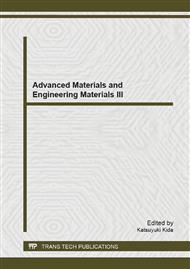p.558
p.562
p.566
p.573
p.577
p.585
p.593
p.597
p.602
Numerical Simulation of Influence of Aggregate-Mortar Interface on Fracture Toughness of Concrete
Abstract:
To explore the feasibility of the approach of "interfacial toughening in concrete", the 2D concrete model which possesses the characteristic of random distribution of spherical aggregates was used to simulate the relations between interface material and toughness of concrete containing flexible interfacial material. The influence of interfacial material on the toughness of concrete was calculated with elastic modulus, thickness and the displacement at peak load for variables. And the results show that: The peak width of the concrete's load-displacement curve is increased evidently with the ultimate displacement also improved evidently upon replacing the normal ITZ with flexible interface phase material; the concrete's peak load, the displacement at peak load and the fracture energy increase gradually with the increase of the elastic modulus of interface phase material. When the elastic modulus exceeds 50MPa, the concrete's peak load will exceed that of normal concrete promptly with the displacement at peak load and the fracture energy all reaching the maximal value; With the gradual increase of the thickness of interface phase material, the concrete's peak load declines gradually while the displacement at peak load increases gradually; The concrete's fracture energy and ductility coefficient approximately increase first and then decline with the change of thickness. When the thickness is 0.2mm, the concrete's fracture energy and ductility coefficient reach the optimal value in setting scope. With the gradual increase of the interface phase material's displacement at peak load, the concretes peak load increases gradually while its fracture energy and ductility coefficient increase first and then decline. When the displacement at peak load is 0.05, the two reach the optimal value; when the displacement at peak load exceeds 0.05, the cracks will extend from the aggregates-mortar base debonding to the mortar matrix. The results have certain exploration value for developing concrete toughening technology.
Info:
Periodical:
Pages:
577-584
Citation:
Online since:
February 2014
Authors:
Keywords:
Price:
Сopyright:
© 2014 Trans Tech Publications Ltd. All Rights Reserved
Share:
Citation:


